Growth marketing is one of those terms that gets thrown around like a tennis ball in doggy daycare.
Yet, you’ll quickly notice that people use the term to mean a bunch of different things.
Sometimes, it’s growth hacking, other times, performance marketing, and in rare (yet unfortunate) instances, it’s Google Ads and Google Ads alone.
Advance B2B being a strategic B2B marketing agency, you can imagine we’re not fans of this crippling confusion. Now, if we're being honest, Growth Marketing ... is just strategic marketing.
Note that we wrote this guide a while back when we believed that Growth Marketing was the shit. But then, we came to the realization that growth marketing and strategic marketing are really two sides of the same coin. But this article also ranked pretty well, and we didn't want to fudge that up. And so, we kept it up, because the content is still very much valid.
Anyway, here's what you'll learn here:
- What growth marketing is
- What growth marketers actually do
- Why we need growth marketing
- How to run your growth marketing operations in practice
- What are the preconditions for succeeding with growth marketing
Otherwise, let's jump right into the blog post itself!
A definition of growth marketing?
Growth marketing is a systematic process that combines strategic brand marketing with tactical performance marketing to acquire good-fit customers and help them become so successful they’ll buy again, buy more, and tell others. Read more about the intricacies of a definition for growth marketing in our blog post on the matter.
And if we were to pick the definition apart, we’d be left with four things:
- Growth marketing is a systematic process. Building from agile development principles and growth hacking practices, growth marketing follows a cyclical sprint model where marketing performance is constantly tracked and optimized.
- Growth marketing combines strategic brand marketing with tactical performance marketing. Growth marketing is measured not only in short-term leads generated but also in long-term brand awareness, demand, and loyalty. (Read more: Brand — the forgotten ingredient in B2B SaaS growth)
- The goal of growth marketing is revenue growth not only through new customer acquisition but also through the activation, retention, and monetization of existing customers. Growth marketing doesn’t end where the funnel ends. Instead, its goal is to help customers become so successful that they want to stay, buy more, and promote your company to their peers.
- Growth marketing is laser focused on serving good-fit customers. Growth marketing is firmly rooted in the idea that marketing budgets should be spent on serving profitable customers who are getting the most value from the product. Beyond that, the primary role of marketing is to create value for these customers, rather than to extract value from them.
While definitions are useful and everything, the easiest way to explain growth marketing is by comparing it to a few more widely accepted concepts.
How is it different from traditional marketing?
Growth marketing differs from traditional marketing in five major ways:
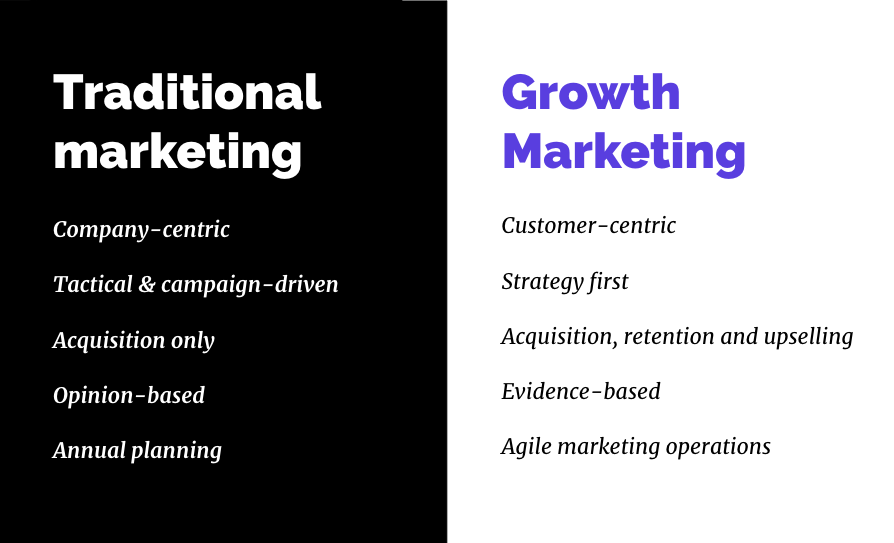
First, it’s not at all uncommon for marketers to never have spoken with their customers. Either they didn’t get the C-level permission to “bother the customers” or the thought of talking to customers directly never even occurred to them. Either way, this kind of approach leads to company-centric and not customer-centric marketing. And that’s literally the opposite of growth marketing.
Second, while traditional marketers too often find themselves in the weeds of new channels and tactics, growth marketers make a point of approaching every tactical decision strategy first.
Third, traditional marketers consider their job done when they’ve successfully acquired a new customer. Growth marketers, on the other hand, are also responsible for activating, retaining, and growing the share of wallet of existing customers.
Fourth, even though every marketer has the opportunity to be “data-driven” these days, a lot of traditional marketing decisions are still based on somebody's opinion. And even if marketers track quantitative funnel metrics like new contacts and marketing-qualified leads, growth marketers obsess over data that’s closer to the business, like customer lifetime value as well as data from qualitative customer interviews and surveys.
Fifth, while traditional marketing is often a function of annual planning, growth marketing recognizes that market conditions are evolving so quickly that marketing needs a more reactive planning cycle. That’s why growth marketing follows a cyclical sprint model, where hypotheses are formed quarterly and new tactics and experiments are prioritized and executed on a monthly basis.
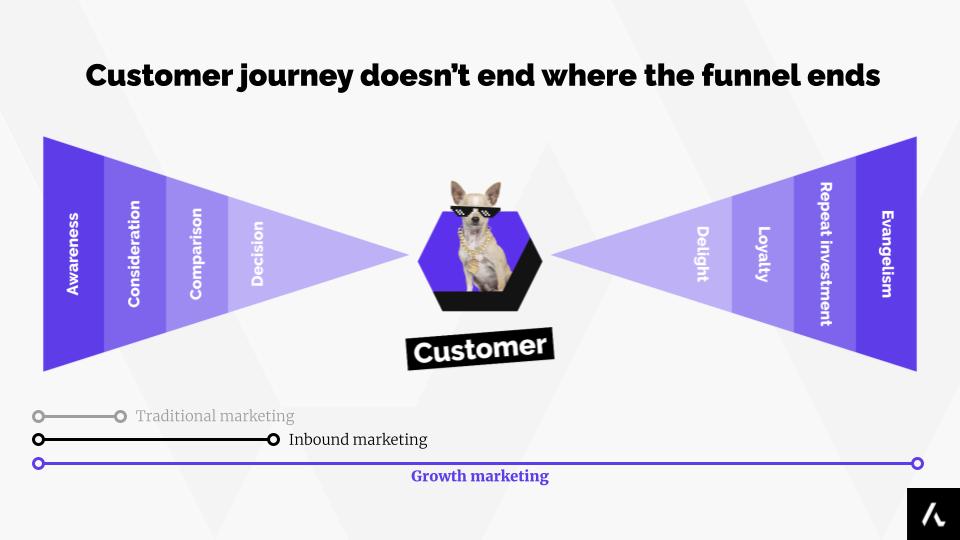
How is it different from growth hacking?
Because there’s so much to unpack here, we actually dedicated an entire post to the similarities and differences between growth hacking and growth marketing.
- Where the ultimate goal of growth hacking is rapid market growth, growth marketing is first and foremost after sustainable revenue growth.
- Growth hacking relies on tactical performance marketing alone, while growth marketing also borrows from brand marketing, where the goal is to create brand awareness, demand, and preference among ideal customers who may not be ready to buy the product just yet.
- If growth hackers are hybrids between full-stack developers and marketers, growth marketers are hybrids between business strategists, customer success managers, and marketers.
- Growth hacking is unquestionably an in-house function, whereas growth marketing operations can be partially contracted out.
And when it comes to the similarities, both approaches are informed by not only funnel and proxy metrics but also revenue metrics, like customer lifetime value and customer acquisition cost.
How is it different from inbound marketing?
Seeing as Advance B2B was formerly known as an inbound marketing agency, we should be well-equipped to answer this question.
The short and sweet is that while inbound marketing is focused on new customer acquisition only, growth marketing is also concerned with keeping current customers so happy that they’ll want to buy again, buy more, and tell their friends.
The important thing to note here is that growth marketing and inbound marketing aren’t exactly competing approaches. In fact, many inbound marketing tactics can be used as part of an effective marketing strategy.
As far as similarities are concerned, both inbound marketing and growth marketing are customer-obsessed disciplines. While their customer-centricity is manifested in slightly different ways, the basic idea is the same: Marketing is meant to help over hard-sell.
How is it different from digital marketing?
Now this is by far our least favorite point of comparison. But because we get asked about it so often, the short answer is this:
Digital marketing is literally any marketing that happens online. Growth marketing is channel agnostic and constrained by the lengthy definition we offered earlier.
Happy? Good. Because we have a lot more ground to cover.
What do growth marketers do all day?
While we’ve just established that growth marketers are channel agnostic, we thought it might be useful to give a couple examples of the kind of things growth marketers like us get up to on a daily basis.
- Customer research. Because first-hand customer insight is such an important success factor in growth marketing, you’ll often find growth marketers on the phone with the end-users of the product or service they're marketing. Glamorous, right?
- Brand marketing. If the product is new, growth marketers might opt for running awareness-increasing tactics, like influencer marketing, organizing or sponsoring events, video marketing, or guest blogging. On the other hand, if the product is awesome but there doesn’t seem to be enough demand for it, it’s very likely that it’s suffering from a positioning problem. Growth marketers can solve that.
- Product marketing. Because growth marketers are experts in conducting customer research, they’re the best people to write product page copy, create sales enablement materials, and put together high-intent Google Ads that speak the language of the target audience.
- Marketing automation. Growth marketers can also design, build, and optimize drip campaigns, automated onboarding email sequences, chatbots, lead capture forms, and workflows.
- Content marketing. Because content marketing can be used for so many purposes including increasing brand awareness, generating organic traffic, converting more leads, and communicating to current customers, there’s usually at least some element of content marketing in growth marketing.
- Paid acquisition. Especially in a company’s early days, SEM and paid social can be important growth drivers. Growth marketers can also use paid channels to test different messaging alternatives for the website or a new campaign.
- Data analysis and reporting. Growth marketers frequently find themselves shoulder-deep in quantitative marketing and customer data from a variety of sources including web analytics and marketing automation platforms, CRM, and the product backend. Their job is to transform this data into logical hypotheses and compelling stories.
- Experimentation. In short: 1) Form a hypothesis (refer to research, analysis, previous experiments), 2) Define experiments and test, 3) Prioritize experiments that are fast to run, have a strong likelihood to succeed, deliver enough data to learn from, and are repeatable and scalable. 4) Track, learn, run another test. (There's also a webinar about this theme if you want to take a look!)
Psst! If you’re interested in this topic, stay tuned for more and subscribe to our Advance Insider newsletter to make sure you won't miss any future posts!
Why do we need growth marketing?
There are two layers to answering this question.
The historical perspective
If we think about the evolution of B2B marketing and sales over the past couple of decades, we can clearly distinguish three phases.

Back before the internet, B2B marketing was all about building, strengthening, and maintaining relationships with prospective customers. Sales processes typically started from cold calls or events, and continued with face-to-face meetings and a lot of late nights wining and dining. By the time the customer was ready to sign his or her name on the dotted line, the sales team and the customer had become good friends.
With the advent of digital sales tools and marketing automation, we found ourselves in a situation where we had more data at our disposal than ever before. Instead of continuing to think of prospects as people, we over-rotated and started treating them as leads, MQLs, and SQLs. Nothing but numbers on a pipeline.
And when you were the first company to offer a significant improvement to an existing way of doing business or a whole new product that never existed before, that was fine.
If you built it, they would come.
But today, the situation is a bit more complex. You can’t just hack your way to growth because your features are no longer unique, you can’t afford to push the price down anymore, and new competitors keep showing up left and right.
And while we’d love to tell you that there’s a completely new and revolutionary way of doing B2B marketing that will solve for these new-found problems, we can’t do that in good conscience.
Because at the end of the day, the solution we're proposing, also known as growth marketing, is really a balancing act between old-school brand marketing and new-school performance marketing, where the ideal customer has regained his status in the front and center of all activities.
A marketer’s perspective
If you’re a marketer who felt a pang reading the description of the differences between traditional marketing and growth marketing, well... We're sorry we made you feel that way. And we definitely have all kinds of empathy for you.
The good news is that it’s probably not your fault if you’re only focused on customer acquisition, if you’ve never done customer research, if you don’t have a crystal clear strategy, or if you’ve been measuring the wrong things.
And if it makes you feel any better, we’ve been like that too. We all have.
As marketers, we’ve been trained to think a certain way, and it’s really hard to break that mould when you don’t know that there’s a different way.
But now, we're hoping that you’re a) still awake and b) dying to get to the juicy part i.e. how you can get started with growth marketing.
How do I run my growth marketing operations?
If you want to do growth marketing well, you need to master two phases: strategy and marketing operations.
Let’s look at each of these in turn.
How to build a growth marketing strategy
A growth marketing strategy is a steering document that’s derived from your business strategy, goals, and customer research. It answers questions like: what is the role of marketing in driving revenue growth, how do we reach the ideal customers of the company, and why are we choosing certain channels over others.
On the business side, before you can build an effective marketing strategy, you need to understand:
- How the company is positioned, meaning who your company is serving and with what kinds of products and/or services
- Who your ideal customers are — if you’re not sure, run this workshop to develop your ideal customer profile.
- What the business goals of the company are — both in the next 12 months and beyond
- How much growth (in percentages) the company is seeking, where that growth is expected to come from and in what timeframe
On the customer side, you’ll want to interview your best customers to find out:
- Which problem(s) they’re trying to solve with your product or service
- What a typical buying process looks like
- What kinds of objections they have during the buying process
- What they consider as the competitive alternatives to your product or service (note: not just direct competition but also not doing anything at all, using a spreadsheet, etc.)
- What made them want to invest in your product service
- What they consider as the best thing about your product or service now that they’re using it
- What are currently their biggest challenges at work
- Where they hang out online
After you’ve gathered all this information, you’re ready to get to the fun part: putting together the guard rails for your marketing ops.
The final document should include at least:
- Your business goals and the marketing goals you’ve derived from those
- An objective and clear definition of your ideal customer profile (e.g. companies that have 2+ full-time people working in accounts payable and that process more than 30 000 invoices per year. Not: large companies with complex financial structures)
- A brief current state analysis, where you identify the biggest bottlenecks and opportunities in marketing
- A list of marketing priorities (e.g. 80% budget spent on new customer acquisition, 10% in retention activities, and 10% supporting cross-selling)
- Your product’s value proposition to your primary audience
- The primary reasons your ideal customers buy (your differentiators)
- A competitive analysis between the perceived market alternatives
- Primary growth marketing channels and your vision for winning in those channels, where necessary
- A foundation for your marketing backlog to bring the strategy to life
Perhaps the most important thing to understand is that the growth marketing strategy isn’t a one and done type of document that you just create and forget, but something that you’ll keep refining once you learn more about the market and your audience through daily operations.
And speaking of daily ops...
How to structure your daily operations
Once you have the first version of your growth marketing strategy in place, you’re ready to start running your first real sprint.
The very first thing you’ll do is choose the “impact owner”, i.e. the person who ultimately owns growth marketing and its results in your company. Their role is to make sure that there are no blockers preventing the rest of the team from getting their work done, and report on the success of growth marketing to the leadership team (and sometimes even the rest of the company).
Next up, you’ll define the cadence of your sprints. At Advance B2B, we’ve chosen to go with 4-week sprints. In our experience, though, anything from 3 to 6 weeks will do the trick — depending on the size of your team, your primary channels, and well… the rest of your strategy.
It’s also a good idea to define the number of story points or credits that are available for each sprint. For instance, if you’re operating in a 3-person team and you’ve decided to with a 4-week sprint model, you could say that you have a total of 384 credits available in each sprint (where 1 credit = 1 hour for 80% of the three people’s time over a 4-week period of five 8-hour working days per week).
Each sprint consists of the same four steps:
Step 1: Sprint planning
Each sprint starts with a sprint planning session, where the whole team comes together to discuss the goals and priorities for the upcoming sprint. During the session, the team will go through the backlog and choose which tactics and experiments will be implemented in this sprint.
Then, the tasks are allocated between the team members. Credits are used to assess how much time and effort each task will take and to make sure that the tasks are split evenly between the team members. Once the meeting is over, everyone knows exactly what they’ll be working on for the next 3 to 6 weeks.
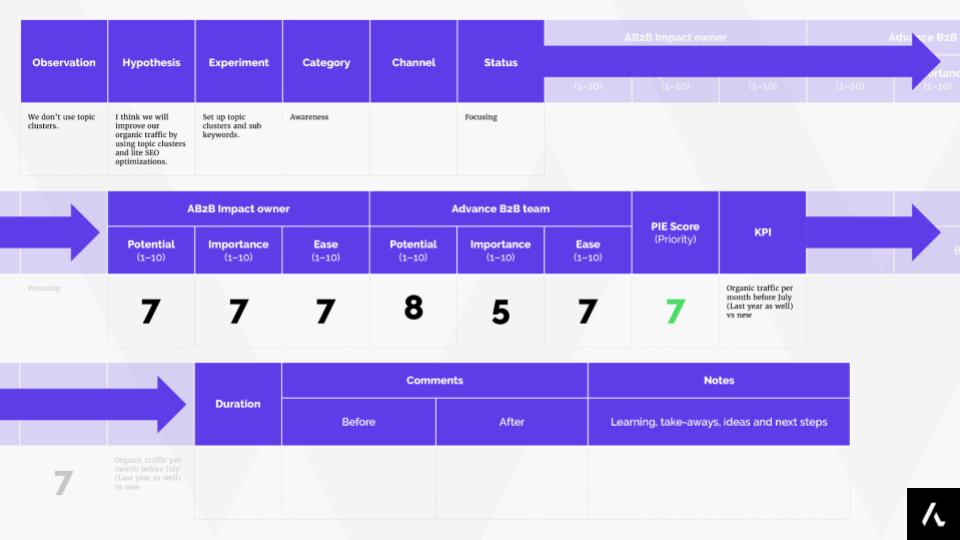
Step 2: Scrums
Once a week (on Monday mornings if possible) the team will get together for a 15-minute weekly scrum, where everyone will briefly explain what they’re working on that week and flag if they have any roadblocks preventing them from getting the agreed tasks done.
Step 3: Weekly reviews
Every Friday afternoon, the impact owner will put together a short weekly review, where she lists all the things the team has been working on that week and shares that with either the leadership team or the whole company. At Advance, we’ve decided to share the weekly with the whole company to make sure that everyone knows what we’re working on.
Step 4: Retrospective
On the last day of the sprint, the growth marketing team will get together for a retrospective, where they review the whole team’s performance. The meeting follows a clear structure:
- Reviewing of the results, which is led by the impact owner,
- Highlights, where everyone raises at least one thing that has gone well in this sprint,
- Fuckups, where everyone raises at least one thing that they could have done better,
- Learnings, where everyone lists at least one thing they’ve learned during the sprint,
- Focus on the next sprint, where everyone can suggest things that they see as priorities for the upcoming sprint.
Here's an example of what it looks like if you're working with us.
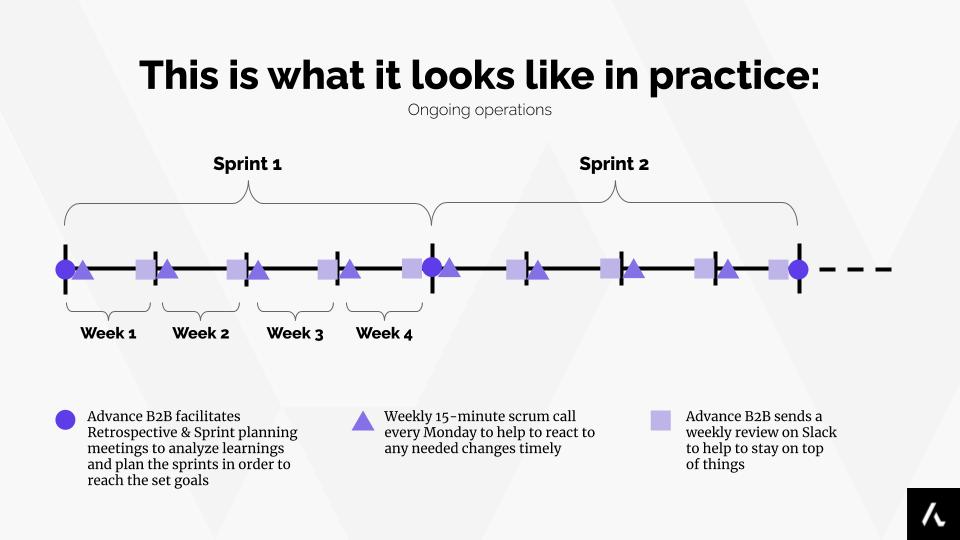
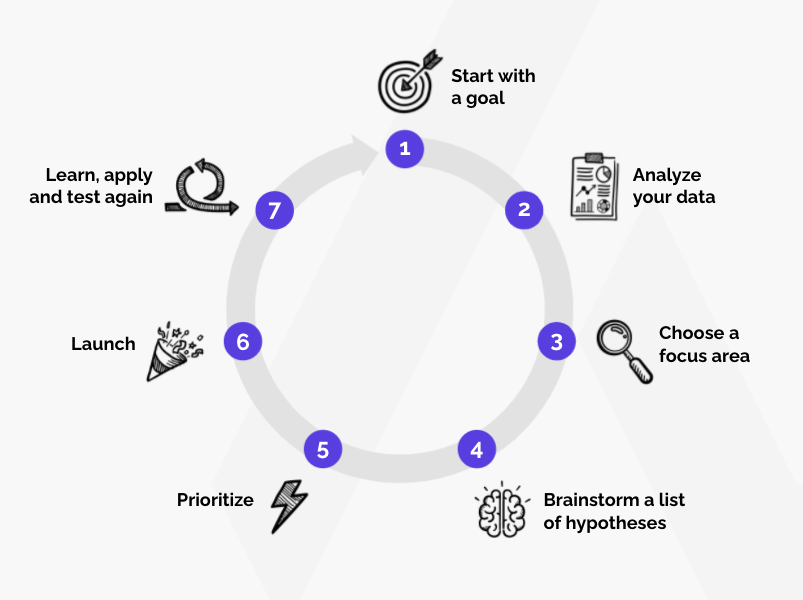
After three consecutive sprints (or a quarter), it’s also good practice to take a step back and review the performance of growth marketing against the growth marketing strategy and put together a more formal quarterly review.
If things are going well and there are no major changes in the market or in the business strategy, the sprint model can continue normally. If, for example, the team has learned about a new Google search algorithm that influences the SEO strategy the team has selected, some credits in the next sprint can be put towards amending the strategy accordingly.
Scheduling and crediting strategy work like customer research or strategy updates is important, because otherwise the team can risk accidentally separating their priorities from those of the business.
Preconditions for growth marketing
For growth marketing to truly work for your business, these three conditions must be met.
I. You have a solid business strategy in place
The biggest bottleneck that indicates your company isn’t ready for growth marketing yet is if you don’t have a clear, documented business strategy in place.
This document should answer questions like: what are you selling and to whom (aka your positioning), what are your growth goals, and where do you expect this growth to come from (e.g. new business acquisition vs. up-selling to existing customers).
The truth is that without a clearly communicated vision on these strategic decisions, your growth marketing strategy will be just as good as shooting in the dark.
II. Your growth marketing team has access to the right data
Now this should go without saying but I’m going to say it anyway: For growth marketing to work, your marketing team needs access to not only marketing metrics but also business metrics.
Why? Because it’s the only way to figure out where the biggest bottlenecks to your growth are and which marketing channels, messages, and tactics are generating customers with the highest lifetime value.
III. Your organization is agile enough
I know that this last one might sound a bit fluffy but bear with me. When we talk about an organization’s agility we simply mean that:
- There’s a clear chain of command, where everyone knows who’s responsible for what and there aren't any unnecessary layers of bureaucracy
- There are minimal silos between teams, especially product, customer success, marketing, sales, and leadership
- Decision-making is decentralized enough so that things can move forward quickly
- There’s an open culture, where people on any level feel like they can point out potential issues or give recommendations without the fear of being punished or ignored
- Following the sprint schedule doesn’t cause any unbearable difficulties
TL;DR
Not all B2B companies are ready for growth marketing just yet, and that’s completely fine. The only problem is that if you don’t start moving towards a more strategic, agile, and customer-centric marketing model soon, you might risk the sustained growth of your business.
Sure, you might still be getting leads in the short term, but once the market in which you operate matures, it’ll be more and more difficult to compete with isolated marketing campaigns or growth hacks alone.
If you want to see a concrete example of how all this actually works, take a look at this customer case story with our awesome customer Virta!




